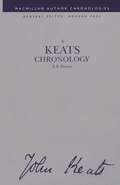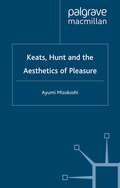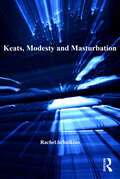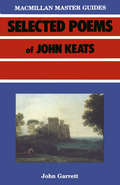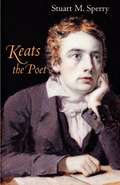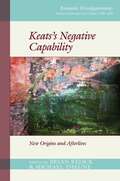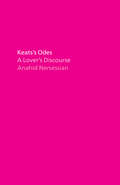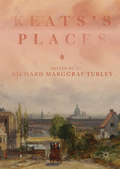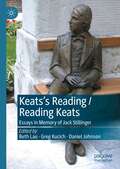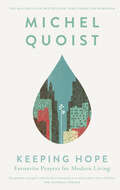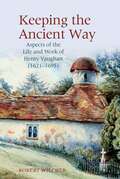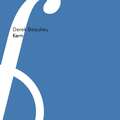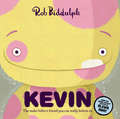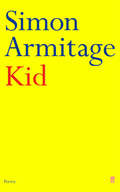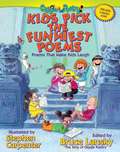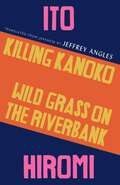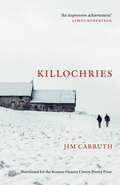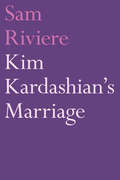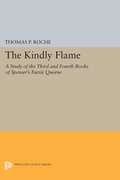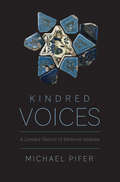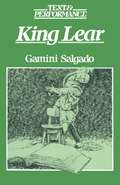- Table View
- List View
A Keats Chronology (Author Chronologies Series)
by F B PinionThis fully detailed chronology makes the best use of Keats's letters to indicate his poetic aims and achievements. It is supplemented by a valuable introduction and interestingly informative sketches of more than thirty persons of importance in his life. With maps and a bibliography, this work is not only an intensely intimate biography but also an exceptionally useful reference book for students and scholars.
Keats, Hunt and the Aesthetics of Pleasure (Romanticism in Perspective:Texts, Cultures, Histories)
by Ayumi MizukoshiThis book tackles the age-old interpretative problem of 'pleasure' in Keat's poetry by placing him in the context of the liberal, leisured and luxurious culture of Hunt's circle. Challenging the standard narrative which attribute Keat's astonishing poetic development to his separation from Hunt, the author cogently argues that Keats, profoundly imbued with Hunt's bourgeois ethic and aesthetic, remained a poet of sensuous pleasure through to the end of his short career.
Keats, Modesty and Masturbation
by Rachel SchulkinsExamining John Keats’s reworking of the romance genre, Rachel Schulkins argues that he is responding to and critiquing the ideals of feminine modesty and asexual femininity advocated in the early nineteenth century. Through close readings of Isabella; or the Pot of Basil, The Eve of St. Agnes, Lamia and ’La Belle Dame sans Merci,’ Schulkins offers a re-evaluation of Keats and his poetry designed to demonstrate that Keats’s sexual imagery counters conservative morality by encoding taboo desires and the pleasures of masturbation. In so doing, Keats presents a version of female sexuality that undermines the conventional notion of the asexual female. Schulkins engages with feminist criticism that largely views Keats as a misogynist poet who is threatened by the female’s overwhelming sexual and creative presence. Such criticism, Schulkins shows, tends towards a problematic identification between poet and protagonist, with the text seen as a direct rendering of authorial ideology. Such an interpretation neither distinguishes between author, protagonist, text, social norms and cultural history nor recognises the socio-sexual and political undertones embedded in Keats’s rendering of the female. Ultimately, Schulkins’s book reveals how Keats’s sexual politics and his refutation of the asexual female model fed the design, plot and vocabulary of his romances.
Keats, Modesty and Masturbation
by Rachel SchulkinsExamining John Keats’s reworking of the romance genre, Rachel Schulkins argues that he is responding to and critiquing the ideals of feminine modesty and asexual femininity advocated in the early nineteenth century. Through close readings of Isabella; or the Pot of Basil, The Eve of St. Agnes, Lamia and ’La Belle Dame sans Merci,’ Schulkins offers a re-evaluation of Keats and his poetry designed to demonstrate that Keats’s sexual imagery counters conservative morality by encoding taboo desires and the pleasures of masturbation. In so doing, Keats presents a version of female sexuality that undermines the conventional notion of the asexual female. Schulkins engages with feminist criticism that largely views Keats as a misogynist poet who is threatened by the female’s overwhelming sexual and creative presence. Such criticism, Schulkins shows, tends towards a problematic identification between poet and protagonist, with the text seen as a direct rendering of authorial ideology. Such an interpretation neither distinguishes between author, protagonist, text, social norms and cultural history nor recognises the socio-sexual and political undertones embedded in Keats’s rendering of the female. Ultimately, Schulkins’s book reveals how Keats’s sexual politics and his refutation of the asexual female model fed the design, plot and vocabulary of his romances.
Keats the Poet
by Stuart M. SperryKeats the Poet was first published in 1973, just as the crest of all the New-Critical exegeses had passed, leaving the critical literature with a wealth of fine readings, but without a real organizing program within which to view them. Stuart Sperry established such a frame of reference. Further, he did so with such prescience that even the most radical deconstructive or new historical approaches to Keats today must bear witness to their inception in Sperry's emphasis on, and subtle demonstration of, the centrality of "indeterminacy' in the poet. Now available in paperback for the first time, this work will enlighten a new generation of readers.
Keats’s Negative Capability: New Origins and Afterlives (Romantic Reconfigurations: Studies in Literature and Culture 1780-1850 #6)
In late December 1817, when attempting to name “what quality went to form a Man of Achievement especially in Literature,” John Keats coined the term “negative capability,” which he glossed as “being in uncertainties, Mysteries, doubts, without any irritable reaching after fact & reason.” Since then negative capability has continued to shape assessments of and responses to Keats’s work, while also surfacing in other contexts ranging from contemporary poetry to punk rock. The essays collected in this volume, taken as a whole, account for some of the history of negative capability, and propose new models and directions for its future in scholarly and popular discourse. The book does not propose a particular understanding of negative capability from among the many options (radical empathy, annihilation of self, philosophical skepticism, celebration of ambiguity) as the final word on the topic; rather, the book accounts for the multidimensionality of negative capability. Essays treat negative capability’s relation to topics including the Christmas pantomime, psychoanalysis, Zen Buddhism, nineteenth-century medicine, and Philip Pullman’s His Dark Materials trilogy. Describing the “poetical Character” Keats notes that “it enjoys light and shade; it lives in gusto, be it foul or fair, high or low, rich or poor, mean or elevated.” This book, too, revels in such multiplicity.
Keats's Odes: A Lover's Discourse
by Anahid Nersessian“When I say this book is a love story, I mean it is about things that cannot be gotten over—like this world, and some of the people in it.” In 1819, the poet John Keats wrote six poems that would become known as the Great Odes. Some of them—“Ode to a Nightingale,” “To Autumn”—are among the most celebrated poems in the English language. Anahid Nersessian here collects and elucidates each of the odes and offers a meditative, personal essay in response to each, revealing why these poems still have so much to say to us, especially in a time of ongoing political crisis. Her Keats is an unflinching antagonist of modern life—of capitalism, of the British Empire, of the destruction of the planet—as well as a passionate idealist for whom every poem is a love poem. The book emerges from Nersessian’s lifelong attachment to Keats’s poetry; but more, it “is a love story: between me and Keats, and not just Keats.” Drawing on experiences from her own life, Nersessian celebrates Keats even as she grieves him and counts her own losses—and Nersessian, like Keats, has a passionate awareness of the reality of human suffering, but also a willingness to explore the possibility that the world, at least, could still be saved. Intimate and speculative, this brilliant mix of the poetic and the personal will find its home among the numerous fans of Keats’s enduring work.
Keats's Places
by Richard Marggraf TurleyAs the essays in this volume reveal, Keats’s places could be comforting, familiar, grounding sites, but they were also shifting, uncanny, paradoxical spaces where the geographical comes into tension with the familial, the touristic with the medical, the metropolitan with the archipelagic. Collectively, the chapters in Keats’s Places range from the claustrophobic stands of Guy’s Hospital operating theatre to the boneshaking interior of the Southampton mail coach; from Highland crags to Hampstead Heath; from crowded city interiors to leafy suburban lanes. Offering new insights into the complex registrations of place and the poetic imagination, the contributors to this book explore how the significant places in John Keats’s life helped to shape an authorial identity.
Keats's Places
by Richard Marggraf TurleyAs the essays in this volume reveal, Keats’s places could be comforting, familiar, grounding sites, but they were also shifting, uncanny, paradoxical spaces where the geographical comes into tension with the familial, the touristic with the medical, the metropolitan with the archipelagic. Collectively, the chapters in Keats’s Places range from the claustrophobic stands of Guy’s Hospital operating theatre to the boneshaking interior of the Southampton mail coach; from Highland crags to Hampstead Heath; from crowded city interiors to leafy suburban lanes. Offering new insights into the complex registrations of place and the poetic imagination, the contributors to this book explore how the significant places in John Keats’s life helped to shape an authorial identity.
Keats’s Reading / Reading Keats: Essays in Memory of Jack Stillinger
by Daniel Johnson Beth Lau Greg KucichThis book explores John Keats’s reading practices and intertextual dialogues with other writers. It also examines later writers’ engagements with Keats’s poetry. Finally, the book honors the distinguished Keats scholar Jack Stillinger and includes an essay surveying his career as well as a bibliography of his major publications. The first section of the volume, “Theorizing Keats’s Reading,” contains four essays that identify major patterns in the poet’s reading habits and responses to other works. The next section, “Keats’s Reading,” consists of six essays that examine Keats’s work in relation to specific earlier authors and texts. The four essays in the third section, “Reading Keats,” consider how Keats’s poetry influenced the work of later writers and became embedded in British and American literary traditions. The final section of the book, “Contemporary Poetic Responses,” features three scholar-poets who, in poetry and/or prose commentary, discuss and exemplify Keats’s impact on their work.
Keeping Hope – Favourite Prayers for Modern Living: Selected Inspirational Prayers from World-Renowned Theologian Michel Quoist
by Michel QuoistPrayers from Michel Quoist, the multi-million bestselling publishing phenomenon, available for the first time as an ebookThe prayers of Michel Quoist are not prayers in the usual sense, but meditations on life. Beginning with seemingly ordinary events, suddenly the light of faith is thrown on some part of our ordinary, everyday existence. Set against the roads, offices and high-rise buildings that frame our modern world, this collection of practical prayers and meditations penetrates the heart of human experience.Rooted in the modern world and in the thoughts and feelings that define our everyday experience, they celebrate our small victories and offer support as we struggle with universal themes – among them self-acceptance, loneliness, despair, ageing, loss and grief. Quoist’s prayers encourage us to celebrate and harness the tools and talents we have at our disposal to make the best of what we have. Editorial Reviews'His greatest strength is that he shows humanity as an asset rather than a liability.' The Catholic Herald'To those long familiar with Quoist’s writing – and those who are new to him – this book may prove a landmark in the spiritual lives of many in a new century and a new millennium.' Peter Costello, The Irish Catholic'Michel Quoist sold millions of books in 27 different languages because of that ability to make prayer possible for the less contemplative among us.' Fr Brian D' Arcy, Sunday World
Keeping the Ancient Way: Aspects of the Life and Work of Henry Vaughan (1621-1695) (English Association Monographs: English at the Interface #7)
by Robert WilcherWritten by one of the editors of the new complete works of Henry Vaughan, Keeping the Ancient Way is the first book-length study of the poet by a single author for twenty years. It deals with a number of key topics that are central to the understanding and appreciation of this major seventeenth-century writer. These include his debt to the hermetic philosophy espoused by his twin brother (the alchemist, Thomas Vaughan); his royalist allegiance in the Civil War; his loyalty to the outlawed Church of England during the Interregnum; the unusual degree of intertextuality in his poetry (especially with the Scriptures and the devotional lyrics of George Herbert); and his literary treatment of the natural world (which has been variously interpreted from Christian, proto-Romantic, and ecological perspectives). Each of the chapters is self-contained and places its topic in relation to past and current critical debates, but the book is organized so that the biographical, intellectual, and political focus of Part One informs the discussion of poetic craftsmanship in Part Two. A wealth of historical information and close critical readings provide an accessible introduction to the poet and his period for students and general readers alike. The up-to-date scholarship will also be of interest to specialists in the literature and history of the Civil War and Interregnum.
Kern
by Derek BeaulieuProposed as a collection of imaginary logos for the corporate sponsors of Borges’s Library of Babel, Kern balances on a precipice between the visual and nonsensical, offering poems just out of meaning’s reach. Using dry-transfer lettering, Derek Beaulieu made these concrete pieces by hand, building the images gesturally in response to shapes and patterns in the letters themselves. This is poetry closer to architecture and design than confession, in which letters are released from their usual semantic duties as they slide into unexpected affinities and new patterns. Kern highlights the gaps inside what we see and what we know, filling the familiar with the singular and the just seen with the faintly remembered.
Kevin: El Amigo Imaginario En El Que Realmente Puedes Creer
by Rob BiddulphThe glorious new picture book from the bestselling, award-winning author of Blown Away and GRRRRR!, all about one boy, one Kevin, and one very special friendship…
Kid (Faber Pocket Poetry Ser.)
by Simon ArmitageKid gives us one of the liveliest poetic voices to have emerged in the last ten years. Simon Armitage's inspired ear for the demotic and his ability to deal with subjects that many poets turn their backs on have marked him as a poet of originality and force.
Kids Pick The Funniest Poems: Poems That Make Kids Laugh (Giggle Poetry #Bk. 4)
by Bruce Lansky Stephen CarpenterBetcha laugh!This is one of the most popular collections of funny poetry for kids ever published. It’s a classic because it’s the first collection of poems selected by kids! It includes clever creations from some of the most popular names in children’s poetry, including Bill Dodds, Timothy Tocher, Joyce Armor, Robert Pottle, Bruce Lansky, and Kenn Nesbitt. Humorous illustrations by Stephen Carpenter make this book even better.
Kids Pick The Funniest Poems: Poems That Make Kids Laugh (Giggle Poetry)
by Bruce Lansky Stephen CarpenterBetcha laugh! This is one of the most popular collections of funny poetry for kids ever published. It's a classic because it's the first collection of poems selected by kids! It includes clever creations from some of the most popular names in children's poetry, including Bill Dodds, Timothy Tocher, Joyce Armor, Robert Pottle, Bruce Lansky, and Kenn Nesbitt. Humorous illustrations by Stephen Carpenter make this book even better.
Killing Kanoko / Wild Grass on the Riverbank
by Hiromi ItoI want to get rid of Kanoko/I want to get rid of filthy little Kanoko/I want to get rid of or kill Kanoko who bites off my nipples. A landmark dual collection by one of the most important contemporary Japanese poets, in a "generous and beautifully rendered" translation. Now widely taught as a feminist classic, KILLING KANOKO is a defiantly autobiographical exploration of sexuality, community, and postpartum depression. Featuring some of her most famous poems, Ito writes in a defiantly autobiographical manner: Kanoko is Ito's oldest child. WILD GRASS ON THE RIVERBANK won the 2006 Takami Jun Prize, which is awarded each year to an outstanding, innovative book of poetry. Set simultaneously in the California desert and Japan, this collection focuses on migration, nature, and movement. At once grotesque and vertiginous, Itō interweaves mythologies, language, sexuality, and place into a genre-busting narrative of what it is to be a migrant. "Japan's most prominent feminist poet" – Poetry Foundation
Killochries: A novel in verse form
by Jim CarruthA verse novella by Glasgow Laureate Jim Carruth, Killochries tracks the relationship of two very different men working a remote farm over the course of twelve months. A young man is sent to work at Killochries, a farm belonging to a relative, after burning out in the city. He is appalled by the absence of his previous life’s essentials, by the remote strangeness of this new world. The old shepherd has never left the hills; has farmed them all his life. He doesn’t care for the troubles of the modern world, trusting only in God, and greets the incomer with taciturn indifference. Through weeks shaped by conflict, hardship and loss a new understanding grows.
Kim Kardashian's Marriage
by Sam RiviereThe 72 poems in Kim Kardashian's Marriage mark out equally sharpened lines of public and private engagement. Kim Kardashian's 2011 marriage lasted for 72 days, and was seen by some as illustrative of celebrity life as a performance, as spectacle. Whatever the truth of this (and Kardashian's own statements refute it), Sam Riviere has used the furor as a point of ignition, deploying terms from Kardashian's make-up regimen to explore surfaces and self-consciousness, presentation and obfuscation. His pursuit is toward a form of zero-privacy akin, perhaps, to Kardashian's own life, that eschews a dependence upon confessional modes of writing to explore what kind of meaning lies in impersonal methods of creation. The poems have been produced by harvesting and manipulating the results of search engines to create a poetry of part-collage, part-improvisation. The effect is as refractive as it is reflective, and disturbs the slant on biography through a bricolage of recycled and cross-referenced language, until we are left with a pixellation of the first person.
Kindly Flame
by Thomas P. RocheScholars have often felt that Books III and IV of Spenser's Faerie Queene were loosely, almost carelessly, structured. Thomas P. Roche, Jr., seeks to show by a close examination of the text that all four books have a logical structure, and that the apparently randomly selected episodes form one complex allegory.Originally published in 1964.The Princeton Legacy Library uses the latest print-on-demand technology to again make available previously out-of-print books from the distinguished backlist of Princeton University Press. These editions preserve the original texts of these important books while presenting them in durable paperback and hardcover editions. The goal of the Princeton Legacy Library is to vastly increase access to the rich scholarly heritage found in the thousands of books published by Princeton University Press since its founding in 1905.
Kindred Voices: A Literary History of Medieval Anatolia
by Michael PiferThe fascinating story of how premodern Anatolia’s multireligious intersection of cultures shaped its literary languages and poetic masterpieces By the mid-thirteenth century, Anatolia had become a place of stunning cultural diversity. Kindred Voices explores how the region’s Muslim and Christian poets grappled with the multilingual and multireligious worlds they inhabited, attempting to impart resonant forms of instruction to their intermingled communities. This convergence produced fresh poetic styles and sensibilities, native to no single people or language, that enabled the period’s literature to reach new and wider audiences. This is the first book to study the era’s major Persian, Armenian, and Turkish poets, from roughly 1250 to 1340, against the canvas of this broader literary ecosystem.
